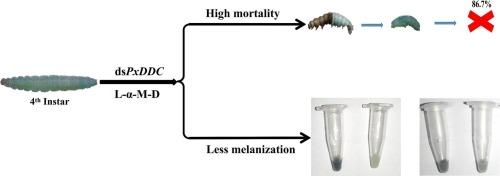多巴脱羧酶在金刚夜蛾幼虫化蛹和免疫中的功能分析
IF 4.2
1区 农林科学
Q2 BIOCHEMISTRY & MOLECULAR BIOLOGY
引用次数: 0
摘要
菱纹夜蛾(Plutella xylostella L.)是危害全球十字花科蔬菜的一种臭名昭著的害虫,对各种常用化学农药产生了高度抗性。多巴脱羧酶(DDC)对昆虫的生存和发育至关重要,本文探讨了多巴脱羧酶是否可作为防治小菜蛾的潜在靶标。本文鉴定了木虱的全长 cDNA(PxDDC),其完整的开放阅读框长度为 1434 bp,编码 477 个氨基酸的蛋白质。时空表达分析表明,PxDDC在蜕皮过程中呈周期性表达模式,在化蛹过程中达到峰值,并在蛹前期的表皮中高表达,表明PxDDC在木虱幼虫-蛹的变态过程中起着关键作用。随后,通过注射dsPxDDC(RNAi,RNA干扰)或喂食添加了L-α-甲基-DOPA(L-α-M-D)作为DDC抑制剂的幼虫饲料来破坏PxDDC的功能后,木虱的化蛹率和羽化率明显下降,黑色素的产生也减少了。此外,我们还发现用L-α-M-D喂养木虱后,4个抗菌肽基因被显著抑制,而且注射大肠杆菌可显著增加酶抑制剂处理后木虱的死亡率,这表明PxDDC也参与了免疫反应。总之,这些结果证实了 PxDDC 是木虱幼虫-蛹蜕变和免疫所必需的,这表明 PxDDC 是未来基于 RNAi 的害虫控制的一个重要的潜在新型杀虫靶标。本文章由计算机程序翻译,如有差异,请以英文原文为准。

Functional analysis of dopa decarboxylase in the larval pupation and immunity of the diamondback moth, Plutella xylostella
The diamondback moth (Plutella xylostella L.), a notorious pest infesting cruciferous vegetables worldwide, has developed a high level of resistance to various commonly used chemical pesticides. In this paper, we explore whether dopa decarboxylase (DDC), which is essential for survival and development in insects, could be used as a potential target for the control of P. xylostella. Here, the full-length cDNA (PxDDC) of P. xylostella was identified, with a complete open reading frame of 1434 bp in length, encoding a protein of 477 amino acids. The temporal and spatial expression analysis showed a periodical expression pattern of PxDDC during molting, reaching a peak during the process of pupation, and it was found to be highly expressed in the epidermis of prepupal stage, indicating a crucial role of PxDDC in larval-pupal metamorphosis of P. xylostella. Subsequently, there was a significant decreasing in pupation and eclosion rates, and less production of melanin in P. xylostella after the disruption of PxDDC function by the injection of dsPxDDC (RNAi, RNA interference) or feeding a larval diet supplemented with L-α-methyl-DOPA (L-α-M-D) as DDC inhibitor. In addition, we found four antimicrobial peptide genes were significantly inhibited after feeding P. xylostella with L-α-M-D, and the injection of Escherichia coli could significantly increase insect mortality of enzyme inhibitor treated P. xylostella, suggesting PxDDC was involved in immune responses as well. In summary, these results confirm that PxDDC is required for larval-pupal metamorphosis and immunity of P. xylostella, suggesting a critical potential future novel insecticide target for RNAi based pest control.
求助全文
通过发布文献求助,成功后即可免费获取论文全文。
去求助
来源期刊
CiteScore
7.00
自引率
8.50%
发文量
238
审稿时长
4.2 months
期刊介绍:
Pesticide Biochemistry and Physiology publishes original scientific articles pertaining to the mode of action of plant protection agents such as insecticides, fungicides, herbicides, and similar compounds, including nonlethal pest control agents, biosynthesis of pheromones, hormones, and plant resistance agents. Manuscripts may include a biochemical, physiological, or molecular study for an understanding of comparative toxicology or selective toxicity of both target and nontarget organisms. Particular interest will be given to studies on the molecular biology of pest control, toxicology, and pesticide resistance.
Research Areas Emphasized Include the Biochemistry and Physiology of:
• Comparative toxicity
• Mode of action
• Pathophysiology
• Plant growth regulators
• Resistance
• Other effects of pesticides on both parasites and hosts.

 求助内容:
求助内容: 应助结果提醒方式:
应助结果提醒方式:


